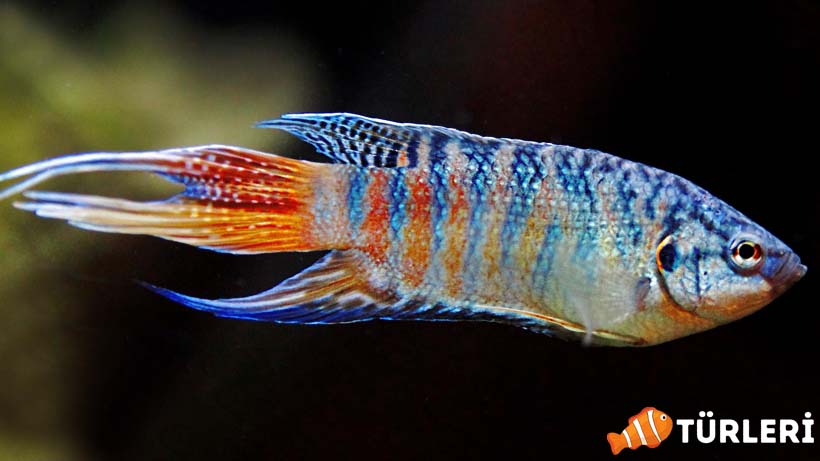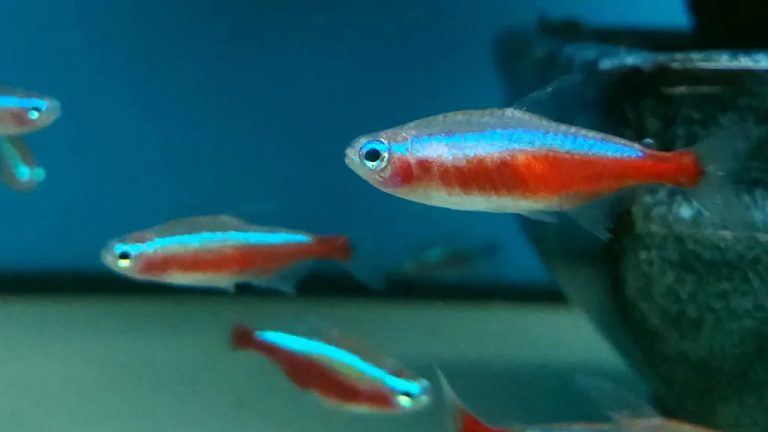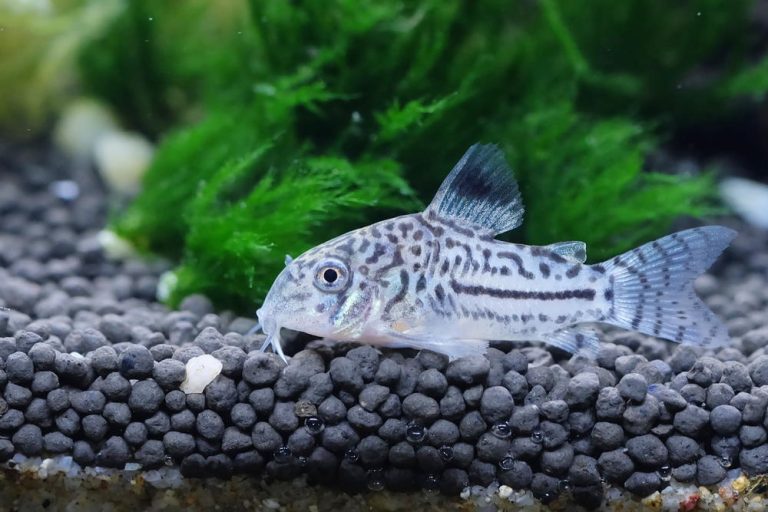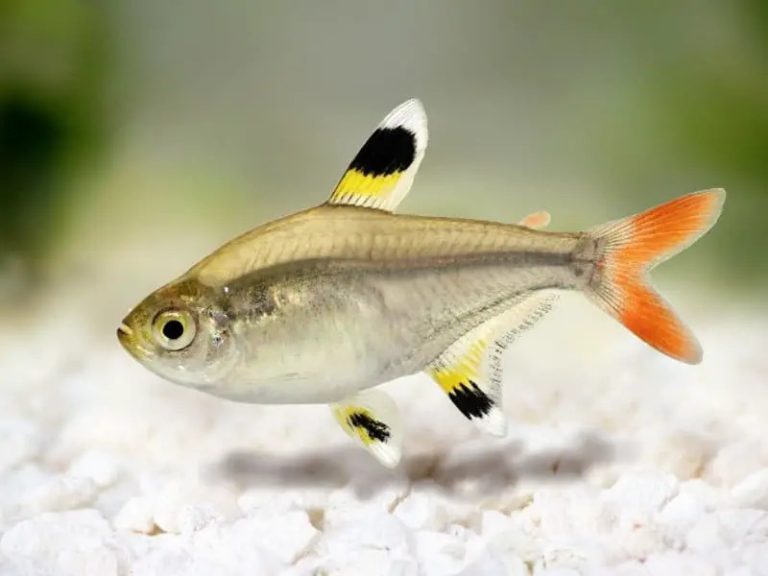Paradise Fish Care Guide
The Paradise Fish is a visually appealing freshwater aquarium fish that many would enjoy watching.
Its distinct colors and behaviors will captivate you. However, due to its aggressive nature, you may face some challenges. Nonetheless, the beauty and resilience of the Paradise Fish more than compensate for its aggressiveness.
This guide will teach you all about the care, features, and other details concerning the Gurami Paradise Fish.
Paradise Fish Species Summary
| Scientific Name: | Macropodus opercularis |
| Origin: | East Asia |
| Diet: | Omnivorous |
| Behavior: | Moderately aggressive (Males are more aggressive) |
| Behavior Towards Its Own Species: | Moderately aggressive |
| Swimming Area: | Mid and surface |
| Water Temperature: | 16 – 26 °C |
| Su Sertliği: | 4 – 20 GH |
| pH Level: | 6.0 – 8.0 |
| Minimum Tank Volume: | 80 Liters |
| Adult Size: | 10 cm |
| Breeding: | Lay eggs |
| Lifespan: | 7 – 8 years |
| Care Level: | Easy |
Features
The Paradise Fish, whose scientific name is Macropodus opercularis, is a gourami species native to the East Asia region. They are found particularly in regions like Korea, China, Vietnam, and Taiwan.
Paradise gouramis are among the most resilient aquarium fishes. They can survive in many different and challenging water conditions. Thus, even if you are a beginner, you will not face any difficulties in their care.
Especially male Paradise Fish might show quite aggressive behaviors, but due to their beauty and resilience, they are still popular species kept in aquariums and ornamental ponds.
Appearance and Behavior

Paradise gouramis are visually stunning, both in terms of colors and patterns. Their long fins and tails showcase their vibrant colors and unique patterns in full.
Their dorsal and anal fins have similar shapes. Regardless of the fish’s color and pattern, these fins end with a thin white stripe.
Like classic gouramis, Paradise Fish have a pointed head and a torpedo-shaped body. They come in several popular color variants.
The most common color combination is a pattern formed with blue and orange that leans towards red. There’s also a plain blue variant, which has faint orange stripes on the tail and fins.
Though they are thought to be highly aggressive, they belong to the group of moderately aggressive fishes. Generally, they swim between the middle and surface levels. Like betta fish, being labyrinth fish, they take in oxygen by coming to the surface.
To minimize their aggression, you should choose the right size of the aquarium and the right tank mates. Otherwise, you might observe excessive aggression.
Especially during the breeding season, male fish will exhibit aggressive behaviors. Before acquiring a Paradise Fish, you must gather information to create the right environment.
Natural Habitat
Their natural habitats are the slow-flowing, shallow waters of Asia. Given the wide range of pH and temperature in these areas, they easily adapt to challenging environments. However, a common feature of all these regions is the abundance of vegetation.
If you are going to keep Paradise gouramis, both for their health and to reduce their aggressive behaviors, a planted aquarium setup will be necessary (an adequately-sized aquarium with simple plants).
Sexual Dimorphism
Choosing a specific ratio of males to females in your aquarium will be beneficial for peace. Fortunately, Paradise Fish is a species that’s easy to sex.
For distinguishing the genders of Paradise Fish, you can look at the following:
- Male Paradise gouramis are larger than females.
- The colors of the male Paradise Fish are brighter and more vivid.
- Females have shorter fins.
Compatible Tank Mates?

When selecting tank mates for the Paradise Fish, you should pay attention to their size. The fish you choose should be non-aggressive and larger than the Paradise Gourami. Paradise Fish will show aggression towards fish of similar or smaller size to establish dominance.
If you don’t heed these criteria, they will continuously attack and might even kill the other fish. The most compatible tank mates for Paradise Gourami are:
- Giant Danio
- Bushymouth catfish
- Bala shark
- Cuckoo Catfish
- Clown loach
Care
The care for Paradise Fish is not complicated. The most critical point is to manage their aggressive behavior. While their resilience to cold, challenging water conditions makes them appealing, if you don’t set up the right environment, their aggression can become challenging.
Aquarium
The aquarium volume should be 80 liters or more. This volume will be sufficient for a single Paradise Gourami. If you want to keep multiple Paradise Fish, you should add at least 30 liters of volume per fish.
To minimize aggression, you should provide as much space as possible. Fish with sufficient space don’t feel stressed and become more docile. Therefore, the size of the aquarium is vital when caring for Paradise Fish.
As for the setup, you should try to mimic their natural habitats as closely as possible. Paradise Fish prefer shallow, heavily planted environments. Therefore, setting up a planted aquarium would be ideal.
Plant choice is up to you. You can easily create a pleasing environment for them using simple plants and moss types.
These fish don’t require many hiding places. However, if you’re keeping them with other fish, you can create hiding spots using rocks and caves.
Since they don’t spend time at the bottom, you can choose the substrate material according to your preference.
Water Parameters
Challenging water conditions aren’t a problem for Paradise Gouramis. They can live in cold waters, so they don’t require a heater. They’re also not demanding regarding pH and gH levels. In short, they’re beginner-friendly and easy-to-care-for fish.
As with any aquarium fish, you need to perform regular water changes and maintenance weekly to remove harmful elements. The required water parameters are provided in a table at the beginning of the original text (Note: the table was not in the provided text).
Feeding and Diet
Paradise Fish aren’t picky eaters. They are both carnivorous and herbivorous. They’ll readily consume tablet, flake, or granulated foods.
For Paradise Gourami, a mixed diet is recommended. You can provide them with a mix of various foods to simulate the diverse diet they would have in their natural habitat.
In addition to your mixed diet, you can also give them vegetables like spinach, peas, and zucchini to aid their digestion. Feeding vegetables every 2-3 days would be highly beneficial.
To ensure they don’t face protein deficiencies and related health issues, you can also use live or frozen foods. Larvae, worms, bloodworms, and brine shrimp are suitable options.
Breeding
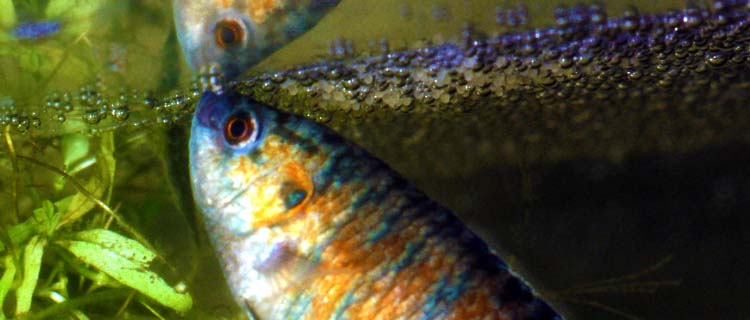
Paradise Fish are relatively easy to breed. Even if you’re just starting out, you can obtain fry from them. Just like with Betta fish, the Paradise Fish will reproduce by creating bubble nests.
While the female Paradise Fish holds the eggs, she will not eat for about two weeks. Therefore, it’s crucial to ensure she’s well-fed before mating.
Breeding Paradise Fish
To start breeding, place the male and female in a separate breeding tank and feed them with live or frozen foods to strengthen them. This will also encourage them to breed. Fill the tank with water, but not completely – only up to 20-25 cm in height (this helps in the proper development of the labyrinth organ in the fry).
When choosing mates, make sure both fish are of breeding size. A breeding male paired with a young female might harm or even kill the female. When it’s time for mating, the male fish will produce bubbles, forming a nest.
After the female lays her eggs, she should be removed from the tank. Otherwise, the male protecting the eggs may become aggressive towards her and cause harm. Depending on the temperature, the fry will hatch from the eggs in approximately 2 to 3 days.
You can expedite this process by increasing the temperature to 27°C (80.6°F). Since the male, who guards the eggs, won’t eat during this period and might consume the fry, you should remove him from the tank after the fry hatch.
Diseases
There are no diseases specific to the Paradise Fish. They can be susceptible to general fish diseases. To keep them healthy and free from disease, ensuring general cleanliness and maintaining clean water is crucial.
Changing at least 25% of the water weekly will help to remove harmful elements like nitrites and ammonia that might accumulate in the tank. Keeping the fish as stress-free as possible can prevent diseases.
In conclusion, Paradise Fish are strong and resilient. The effort required to keep them healthy is relatively less compared to many other aquarium fish.
If one wishes to care for these fish, the most important consideration is managing their aggressive nature. We’ve provided the necessary conditions in our guide to help you achieve this.
Please don’t hesitate to use the comment section for all your questions, feedback, and suggestions.
FAQs
How Should the Paradise Fish Be Fed?
They don’t have specific feeding requirements. In general, to maintain their health and to keep their colors vibrant, it’s suitable to occasionally provide them with live and frozen foods.
Is the Paradise Fish Resilient?
Yes, paradise fish are among the most resilient aquarium fish. Their adaptability to both water conditions and challenging environments makes them one of the robust fish species.
Is the Paradise Fish the Same as the Betta Fish?
No, the paradise fish is a different species from bettas. Although they have many similarities in terms of behavior and appearance, they are distinct fish species.

